
Oyster growers celebrate the end of disastrous 2020
November 10, 2020
By Julia Hollister
After weary and exhausted 2020 collects its memories and shuffles out the door, some of America’s oyster farmers recall the year’s challenges and raise their glasses to bright resolves for the New Year. Julia Hollister reports.
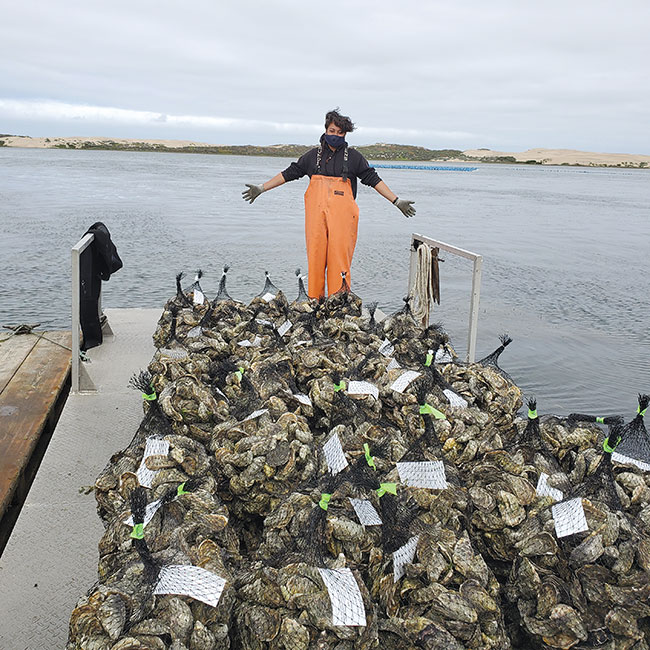 Employee Sydney Wewerka bringing in harvest at Grassy Bar Oyster Co Photo: George Trevelyan
Employee Sydney Wewerka bringing in harvest at Grassy Bar Oyster Co Photo: George Trevelyan GRASSY BAR OYSTER CO
Morro Bay, California
George Trevelyan, president of Grassy Bar Oyster Co. admits 2020 is a “unique and interesting” year with sales dropping 50 percent.
There were new challenges he had not expected.
“There are those refuse to wear masks and come in the store unmasked and scoff at the pandemic as if it was a democratic hoax,” he said. “There are unmasked octogenarian restaurant owners who crowd their kitchens with workers with little protection. It’s awkward and annoying to have to try to keep my staff safe while spending the day with these knuckleheads!”
The Central California operation rebounded with opening a retail store and local deliveries. Trevelyan also learned that oyster farming is essential and that people still want to eat oysters. “This made our business is remarkably resilient,” he said.
“There is a ‘silver lining’ to the COVID-19 outbreak,” Trevelyan added. “My team is stronger now because we’ve learned how to deal with a difficult challenge. We will open a new oyster bar and store.”
The farm will boast a new look in the New Year as new markets emerge.
Prior to the pandemic, the company focused more and more on extra-small, cocktail-sized oysters for fancy oyster bars in the cities. It was the most lucrative product because the oysters are young, small and easy to ship. However, demand nose-dived to near zero during the pandemic.
Trevelyan and his team discovered “Big is Better” with the demand for large grilling oysters. His team learned the importance of staying diversified with products for “regular people” and not just high-end restaurants.
“I am really looking forward to when we have better therapies and a vaccine for COVID,” he said. “I think we all will be overjoyed and primed to celebrate going out to eat oysters.”
TAYLOR SHELLFISH
Shelton, Washington
The Washington State oyster company has survived a number of challenges in its 100-plus-year history, but they had not anticipated a total collapse of their markets because of a pandemic.
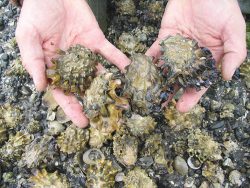
Cultchless oysters from Taylor Shellfish
Photo: Taylor Shellfish
“Seventy-five percent of our business dropped at its worst late in March and for the month of April,” said director of public affairs Bill Dewey. “Because Taylor Shellfish serves significant markets in Asia, impacts to the company began in January, when the Asian markets began to close. Impacts worsened when social distancing in the US began reducing restaurant visits.”
Business worsened when government-mandated closures shut down the restaurant industry almost overnight in March. At the end of 2019, the company’s shellfish and restaurant operations employed just over 700; that number dropped to 175 in April.
Dewey thinks the pandemic has forced the company to further diversify its markets so it is not reliant on the foodservice sector. For example, the demand for shucked oyster meat in the shell is exceeding supply because of its popularity for home baking and barbequing.
Investments continue. The company has recently installed a closed, recirculating, refrigerated wet storage (live holding) system for oysters. “The system has 90,000 gallons of seawater capable of holding 30,000 dozen oysters. The advantages of the system is that it holds the oysters live at temperatures critical to maintain product health and safety and have them readily available for packing orders at our processing facilities,” said Dewey.
In spite of the setbacks, Taylor Shellfish is optimistic about 2021 and is committed to coming out the other side of the pandemic.
REAL OYSTER CULT
Duxbury, Massachusetts
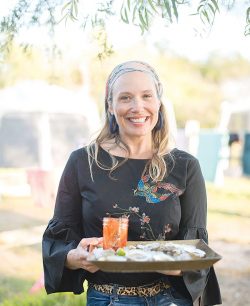
Sims McCormick, co-founder of Real Oyster Cult, holds a tray of her appetizing oysters
Photo: Rosemary Tukankjian
Sims McCormick, co-founder of Real Oyster Cult, admits that as a company with only a few years under its belt, the impact of COVID-19 was very scary and challenging. But, things could have been worse.
“When we created the company, we focused on the direct-to-consumer market,” she said. “COVID has blown up e-commerce and direct-to-customer retail across the board, so this has proven to be a very good choice. We feel lucky to be in the right place at the right time.”
The company’s model is flexible and technology enables it to be nimble. With the normal supply chains completely shut down for the first few weeks of the pandemic, partner farms made special deliveries and continued to support “Cult” with product.
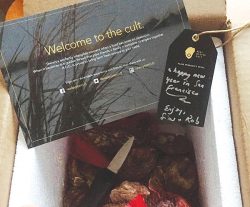
Real Oyster Cult delivers oysters from over 70 farms directly to consumers Photo: Real Oyster Cult
“I do see a ‘silver lining’ to the pandemic,” McCormick said. “It has forced everyone to re-evaluate how they operate their business or farm. Consumers are taking a hard look at their food sources, and what they’re buying. Home cooking is at an all-time high so it is good for grocery stores and farmers, as well as direct-to-customer retail.”
No expansions are planned for the farm’s New Year; and there are concerns. Real Oyster Cult works with many small farms and worry that these farms could find it hard to stay in business. The key is discovering new markets. McCormick’s optimism grows.
“With all current trends showing huge growth in the e-commerce direct-to-consumer marketplace, Real Oyster Cult is positioned well to capitalize on that demand,” she said. “We are certainly stronger, and we’re excited about the future.”
TOMALES BAY OYSTER COMPANY
Marshall, California
Nine feet of rain, a huge die-off of oysters and the arrival of COVID-19 challenged all aspects ofTomales Bay Oyster Company’s farm and crew, and left an unknown with it every day.
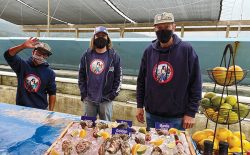
Tomales Bay Oyster Co employees (from left) Salvador Garcia, Jordan Day and Dwight Plunkett show-off oysters Photo: Heidi Gregory
But, new markets emerged.
“We had a few restaurants drop off but our retail/farm stand business increased,” said Heidi Gregory, farm manager and an owner. “Our main operation is people coming to buy oysters, clams and mussels from us, like a farm stand. ‘Bring a cooler. We have oysters and ice.’ People coming to see us was a way to get out of the house, take a long drive and get some oysters, clams or mussels to enjoy in the backyard with the family.”
The pandemic presented some unexpected challenges.
The nearest town is 6 miles away, with a gas station, popular mecca for cheese, milk, organic food, national parks, beaches, road biking, scenic drives, motorcycles and about an hour from San Francisco. Locals didn’t want people coming with the chance of bringing infection into the community. In response, the oyster farm’s promotional efforts encouraged people come get oysters and head home.
“There is a bright side to the outbreak on so many levels. I am optimistic about 2021,” Gregory said. “People are forced to slow down, look around, breathe and spend time with their families. Nature needs a chance to breathe and be loud within the silence created by the absence of cars, planes and trucks. Farming is a 50/50 chance; one year can be totally different from the last one.
“We just keep trying to be better stewards of the ocean, educate, participate and see what happens.”
Advertisement
- Science says fish farms pose minimal risk to wild salmon
- Atlantic Sapphire milepost: first harvest hits retail





